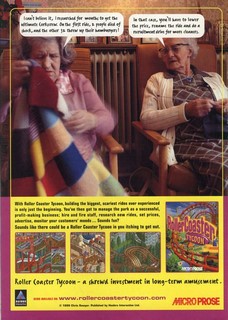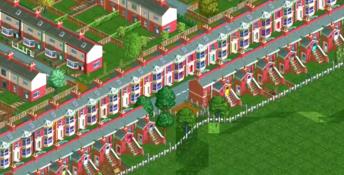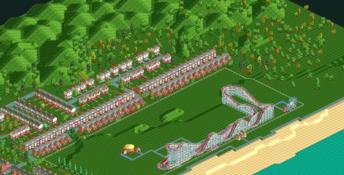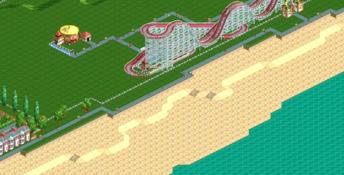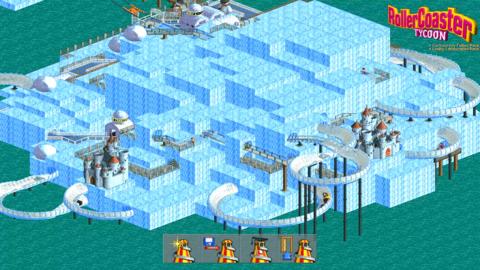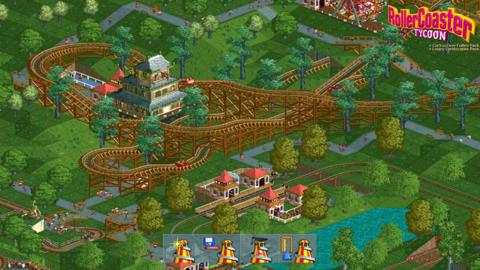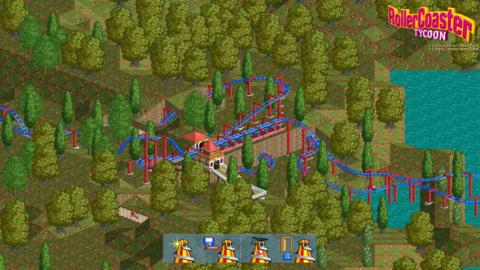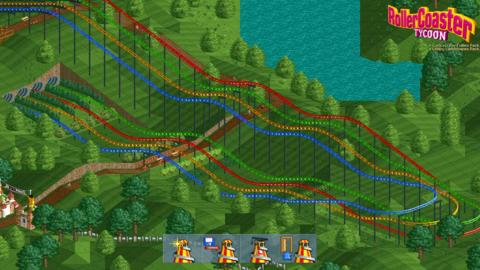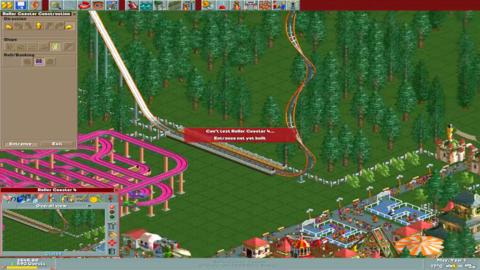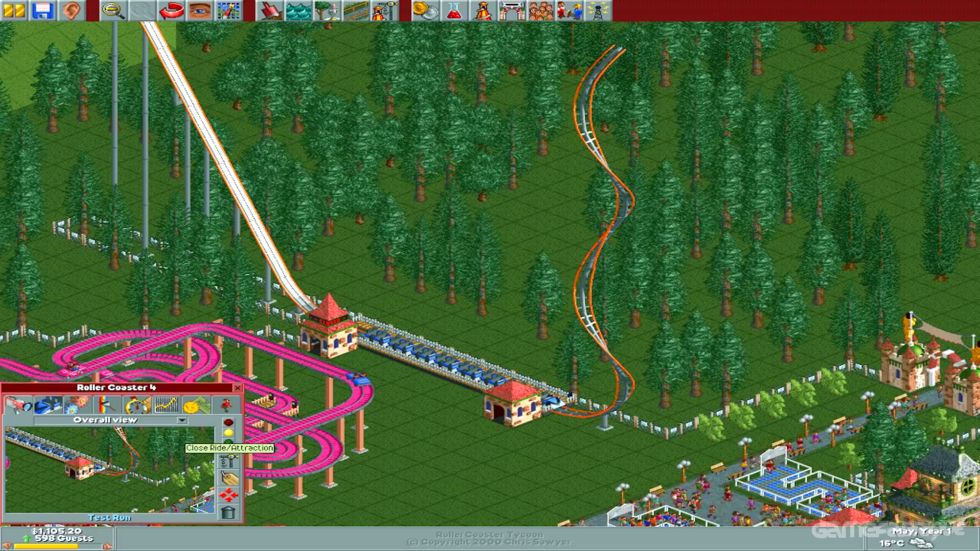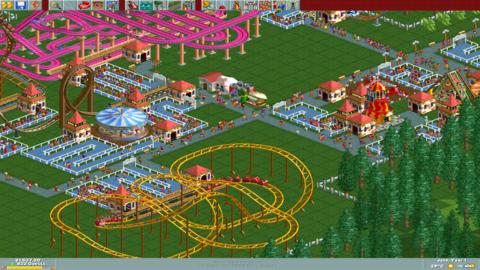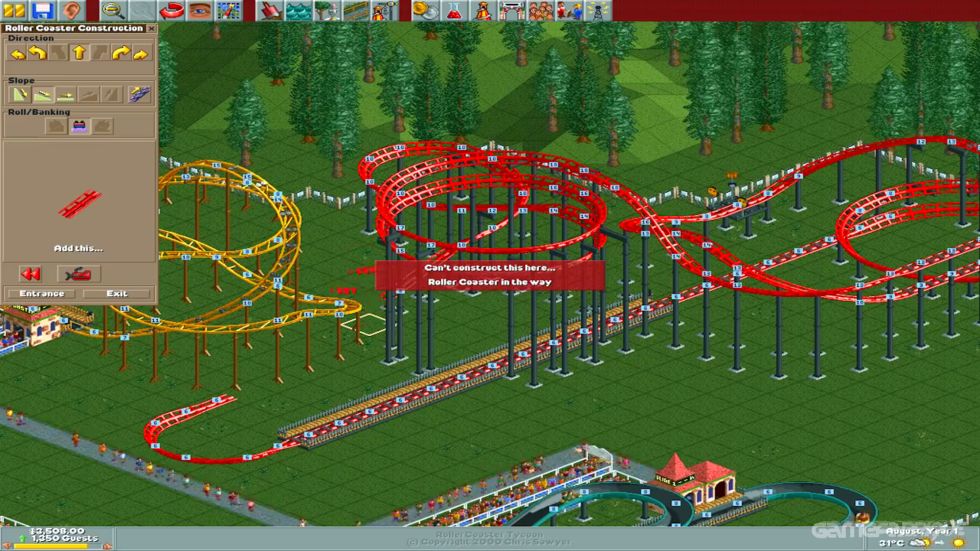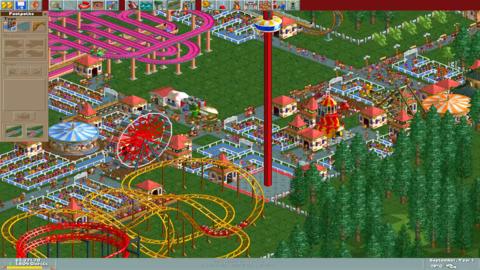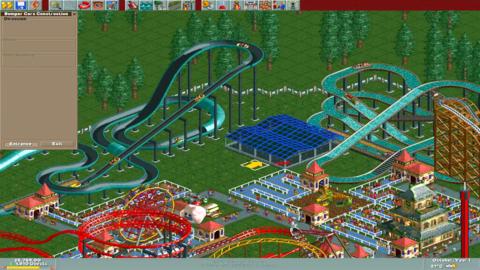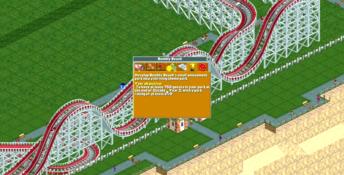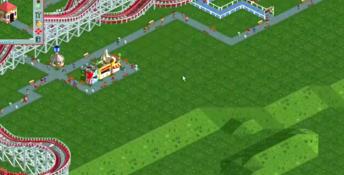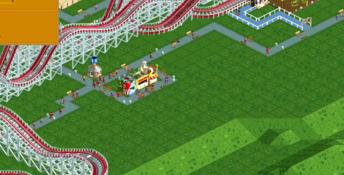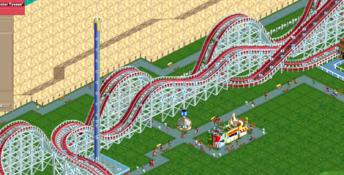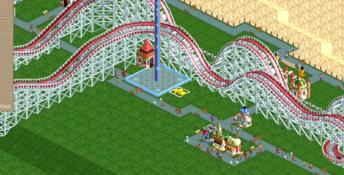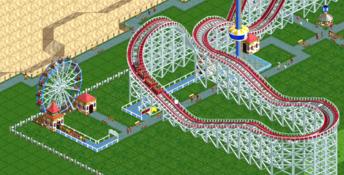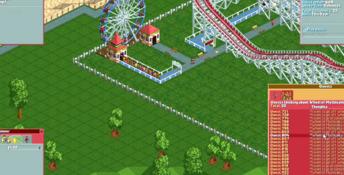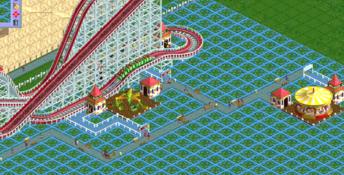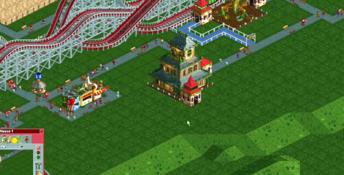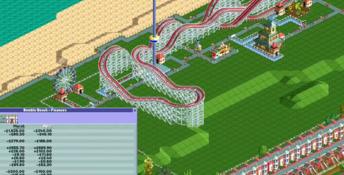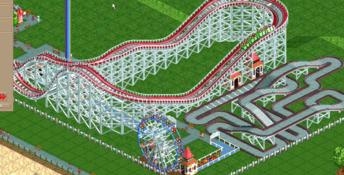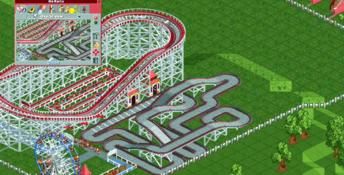RollerCoaster Tycoon
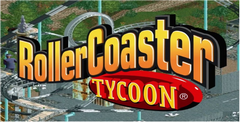
| a game by | Chris Sawyer Productions |
| Genres: | Adventure/RPG, Strategy/War |
| Platform: | PC |
| Editor Rating: | 7/10, based on 1 review, 3 reviews are shown |
| User Rating: | 7.9/10 - 28 votes |
| Rate this game: | |
| See also: | Tycoon Games, RollerCoaster Series |
Walkthrough & Strategy Guide
Completing all 21 scenarios in Rollercoaster Tycoon requires serious amounts of practice. This strategy guide offers tips on how to build bowel-shaking rollercoasters, as well as more general hints on the day-to-day management of your would-be Alton Towers. Finally, there's a brief walkthrough of each scenario to put you firmly on the right track. Let's roll...
Building A Successful Rollercoaster
Building intense, exciting, non-nausea-inducing rollercoasters is the Holy Grail of theme park design. To achieve this golden aim you need to learn how to manage G-force.
Finding The G-Spot
While standing motionless, you are experiencing 1G. That means if you weigh 12 stone, you weigh... well, 12 stone. If you add speed and resistance to the equation, such as you dropping 100 feet at 70mph and shooting straight back up into an inverted loop, you are being subjected to a force greater than gravity. In fact you're probably pulling about four vertical Gs, which means you now weigh four times your usual weight. That's some force. And, as you'd expect, it hurts.
Generally speaking, in Rollercoaster Tycoon it's best not to exceed 4G too often -and especially negative Gs, which occur when cars come off a straight section of track and hit a bump at high speed, or plummet down a drop with too much initial velocity, which causes weightlessness. While it's extremely exciting for a brief moment, prolonged experience simply causes your guests to spew. If one of your coasters has a high negative G rating, sort it out immediately.
G-force also works laterally (side to side). (Are you sure about all this? - Science Ed.) If you design a ride that hits about 5G laterally, you're basically snapping necks. Overall, you want to keep your Gs to a level that's reasonably pleasant for people to experience. By all means give the punters a bit of a shock and a thrill, but excessive exposure to high Gs is the wrong way to do it.
Excitement
Exciting rides are not necessarily fast, nor do they have loads of twists, loops and turns. A high rating in the 'exciting' category usually comes from building a ride that goes over water, through tunnels, past themed scenery or close to another attraction. For example, a section that dives into a tunnel after a sharp drop, emerges into bright sunlight, performs a sharp 90-degree banked turn and darts back into the darkness rates highly on the excitement scale, but doesn't make the passengers vomit.
Also, build uphill sections of track so that cars have just enough momentum to get up and over. If passengers think they're not going to make it, and are going to plummet backwards down the track, they become even more excited. Indeed, later add-ons enable you to do just that, but to do it safely. But beware: going too fast backwards is likely to be messy.
To keep the interest factor high on slower sections of track (usually near the end), use banked helix turns. This type of curve maintains speed, and gives the rider the impression of speed.
Intensity
The trick is to study the graph when you first test a ride. Look at the places with high and sudden G-forces, then smooth them out. Inserting banked corners - or, God forbid, even brakes - can usually do this. Above all, make sure the car doesn't come into the station too fast. Coming out of the last turn at 50mph and then suddenly braking to Omph in less than a second is pretty intense; unfortunately it's also the equivalent force of a fatal car accident. Sure, the guests want some intensity in their lives, but giving it to them like that is a sure way to make them leave the park completely -possibly in a body bag.
Nausea
Beginners usually find that most of their rollercoasters have high nausea ratings simply through a lack of understanding of rollercoaster dynamics and physics. Follow the guidelines outlined in the Excitement and Intensity sections above to reduce the nausea rating.
The Price Is Right
Never charge more than Pound-2 for any food or drink item, and try not to go above Pound-1 for a map, and Pound-3 for an umbrella. When it comes to rides, 50p for a gentle ride, Pound-1 for a thrill ride and Pound-2 for rollercoasters, go-carts, and water rides is about right. Try not to charge for the toilets, or transportation rides like the monorail. That's just greedy.
The admission price should start at about Pound-10 and increase gradually from there. Let's say that each attraction (including stalls) is worth Pound-1.50 on the entrance fee. This means that a park with ten attractions should charge Pound-15 quid, Pound-30 for 20 attractions, and so on. Basically you'll know if the price is right anyway, because your punters will no doubt squeal about it if they're unhappy.
Watch the animations of your guests. If they wander up to an attraction and leap backward in surprise with their eyes popping out of their head, something is wrong. Check out the price of your ride and put it right. On the other hand, if people come off a ride and jump with joy, then you know a ride's popular, so maybe jack up the price a little to maximise revenue.
Workforce And Patrol Zones
Always give your workers relatively small patrol zones, otherwise the good-for-nothing slackers just wander about aimlessly, reducing park efficiency. When you employ a handyman, order him not to water the gardens or mow the grass -it's a waste of time. Instead assign him to areas near ride exits, food and drink stalls and litter bins, and get him to sweep the pavement and empty the bins.
Mechanics should be given zones that cover maybe five or six rides. Inspections of the rollercoasters should take place every 20 minutes, and everything else every 30 minutes.
Not all parks need security patrols, but if you do require their services, position them around vandalism hot-spots such as benches and litter bins.
The Scenic Route
Try not to destroy ready-made scenery and themes; guests are absolute suckers for something that looks pretty. Try to add fountains, statues, lamps and other gadgets, which all go towards making a more scenic environment that people are less likely to leave. Most useful of all are themed rollercoasters and other rides. Not only do they look cool, they also actually increase the excitement factor of the ride.
Right On Queue
When you site an attraction, remember to leave enough room for a queuing area. Rollercoasters, go-carts and water-based rides tend to be among the most popular, and so need the longest queuing areas (7-10+ blocks), then it's thrill rides (4-6 blocks), and finally the gentle rides (2-3 blocks).
Even though it's fairly common practice at most real-life theme parks, in Rollercoaster Tycoon you don't actually need to queue at any of the refreshment stalls, so don't bother building queuing areas by them. Another thing: if a ride takes about two minutes, people are going to be queuing for longer than a ride that takes only ten seconds. Think about this and plan appropriately.
Occasionally guests complain about long queues. If this happens you can do one of two things: either extend the station platform (rollercoasters etc), or raise the price of the ride to scare a few people away. On the flip side, if a ride has no queues at all, reduce the price to attract people to it. It's usually the gentler rides that guests start to lose interest in, and if this happens just swallow your pride and keep reducing the price. Don't worry about making a loss, there are
The Path To Success
Pathways obviously enable guests to get from one part of the park to another, but they also serve as viewing platforms. Position your paths so that they meander tantalisingly near rollercoasters and other interesting-looking rides. Put a few benches down as well so that people can gaze at the ride while they eat their pizza or whatever. Dig some tunnels. Do anything humanly possible to make the pathway an attraction in itself.
Marketing Talk
If all else fails you can always spend a bit of extra cash on marketing campaigns, although generally speaking they are most effective at the start and end of a scenario. One cunning tactic you can use if you're short of guests with about six weeks to go is to have a massive blanket advertising campaign and entice revellers that way.
Scenarios In Brief
Because the tactics for the completion of each scenario are essentially the same, here's a quick walkthrough outlining the main points.
Forest Frontiers
Set the park entrance fee at around Pound-15. Go for the 'woodchip' rollercoaster and spread a selection of gentle and thrill rides around it. Employ a mechanic and two handymen to keep things ticking over. Only research ride improvements.
Dynamite Dunes
Increase entrance fee to Pound-20. Build a selection of rides around the initial rollercoaster. Employ four handymen and two mechanics to keep the park in shape. Finally, reduce the ride prices towards the end of the second year, and start some marketing campaigns to attract punters.
Leafy Lake
Build a pre-made rollercoaster near the entrance, and another on the other side of the lake. Pad out the rest of the park with a varied selection of gentle and thrill rides. Security is needed, as well as some handymen and mechanics.
Diamond Heights
Hire three mechanics, two security guards and about five handymen. Build an information kiosk, food and drink stalls and some toilets near the entrance. Introduce some gentler rides and a few thrill ones. Start a marketing campaign for the new attractions, then sit back.
Evergreen Gardens
Research stalls early so you can get the information kiosk, otherwise your guests will become lost. There's loads of room available, so spread your rides around the park; position them between scenic areas so guests have exciting walks. Build a steam train or monorail to help guests get around the park. Flatten the land, and add minor rides along the existing pathways. When you can, build a wooden rollercoaster somewhere in the middle of the islands. Advertise it and the punters should start flooding in. Raise the admission fee to Pound-20. Create more land. Add new rides.
Katie's Dreamland
Set the admission price at Pound-20 for some quick cash. Get your guests eating food, and hire more mechanics. Raise the price of Runaway Plumber to Pound-3. Research thrill rides and place them in the area just outside the rollercoaster.
Pokey Park
Demolish the Twister in the corner and replace it with a wooden rollercoaster. Raise the admission price Pound-10. Gradually replace all the rides with more exciting ones, and aim for another rollercoaster to finish off.
White Water Park
Research nothing but thrill rides, and add them to the vast array of water-based outings. There's loads of room for expansion, so try to get in a coaster or two. Add two clusters of refreshment stalls - one near the entrance and one near the log flumes.
Millennium Mines
At first the only thing in this massive mine area is the train. Add another station towards the far side of the mines, then start adding a selection of rides around the two stations. Aim for about 30 attractions, and make use of the underground.
Karts & Coasters
One mechanic in this place? That's a joke. Hire another one, and assign them to two rides each for now. Clear away some trees and add some thrill rides -keep this park for the hard-core adrenalin addicts only.
Mel's World
There's nothing really too abnormal about this scenario apart from the vast number of people you have to entice in. Basically, work faster than usual and add a few gentler rides to appeal to families.
Mystic Mountain
Ultimately you want to set up a meaty mine car rollercoaster around the original scenery on the mountain. There's loads of room for park expansion, and this should enable you to create some hugely enjoyable rides.
Pacific Pyramids
Another one to build from scratch, but yet again there's acres of room for expansion. Wrap some tracks around the sphinx for added effect, and also expand upon the existing underground tunnel system.
Crumbly Woods
Not long after you begin, Double Trouble crashes, and soon other rides meet the same fate. Hire an army of mechanics to keep the old attractions going while you build new ones. Add themes wherever possible to attract the 1200 visitors you need.
Paradise Pier
Don't worry about the lack of land, you can build wherever you want. There's loads of space for everything, so go for some huge rollercoasters. Be careful with your money though - building on water is more expensive than building on land.
Lightning Peaks
There's scope for some giant drops and intense underground rides here. Concentrate your attractions around the top of the three peaks and include refreshment stalls and other vital amenities. The main problem here is rain, so build plenty of information kiosks where your visitors can buy umbrellas.
Rainbow Valley
The local authorities won't allow you to demolish trees or change the landscape, so tread carefully. Go underground or high above ground. Alternatively, build in the water - there's enough of it.
ThunderRock
A great place for a mixture of open-air and underground rides. Stick all the thrill and gentle rides around the base and on top of the rock. Build the rollercoasters inside, and clinging to the outside walls.
Download RollerCoaster Tycoon

System requirements:
- PC compatible
- Operating systems: Windows 10/Windows 8/Windows 7/2000/Vista/WinXP
Game Reviews
Those of you too fat, lazy and palsied to get off your lardy arses and go to actual, real-life amusement parks will no doubt be overjoyed to hear that Hasbro Interactive is giving you the opportunity to expand your virtual rollercoaster experiences from the safety of your own sofas.
Loopy Landscapes is the second add-on pack to be released for Chris Sawyer's theme park-inspired Rollercoaster Tycoon and comes complete with the vomit-inducing rides at Blackpool's Pleasure Beach and Alton Towers. All rides are open for editing, meaning you can try your hand at killing gangs of hapless punters before the real ones eventually do. Other additions to the original game include new urban, desert and arctic scenery, a medieval castle theme, T-shirt stands and that other over-rated American blight on modern-day living - the coffee shop.
"We are delighted to be working with Hasbro and are extremely pleased with the way Chris Sawyer has managed to recreate Blackpool Pleasure Beach and its rides," claimed some non-entity for the seaside resort. While Sawyer, under no false illusions about the importance of his game, also commented on the pack: "Even after four years, Rollercoaster Tycoon still fascinates me. I took on the challenge of creating a second add-on pack and this is the result." - Presumably, the challenges of paying the rent and creating something original were totally beyond him. The aptly-named Loopy Landscapes is out at the end of September. I bet you just can't wait.
Rollercoaster Tycoon is a simulation game from 1999 that puts you in charge of your very own theme park! Starting with bare land, you get to decide what rides, amusements, and food stands your park will have. It's not that easy, though! In addition to choosing the rides, you'll also have to accurately price admission, keep your park clean, hire mechanics and handymen, and keep track of quite a bit! Despite having a pretty complex set of options, Rollercoaster Tycoon feels easy to learn and incredibly fun to play, thanks to its intuitive design and bright visuals. If you've ever dreamed of designing or owning your own theme park, you should definitely check this simulation title out!
When you first start up Rollercoaster Tycoon, you'll choose between a handful of “scenarios”. These serves as the game's missions, where you are tasked with specific objectives. For instance, the first scenario, Forest Frontiers, tasks you with gaining a certain number of guests in your park before a specific date. As you complete scenarios, you'll unlock new ones, and each one offers a unique experience. In total, there are 21 different scenarios in the base Rollercoaster Tycoon game, with later expansion packs bringing that number up to 81. While most scenarios offer you a set time limit and a small selection of rides, later scenarios really open up the possibilities, providing you with endless cash and a huge land mass to create within.
When it comes to customization, Rollercoaster Tycoon is utterly packed to the seams. Nearly every aspect of your park can be customized, including the name, the price of admission, and much more. Every time you install a new ride or food stall, you can give it a custom name, color design, and price. Attractions aren't the only priority though; you'll want to make sure your guests keep a positive mood while visiting your park. This means you'll have to adjust prices based on customer reactions, build enough bathrooms for your rising guest numbers, and more. As rides break down and the park gets dirty, you'll also have to hire on handymen and mechanics to keep things running smooth. For an added boost in guest happiness, you can also hire on various entertainers and mascots to roam the park.
Some scenarios will place you in a specific environment, such as Pacific Pyramids, a sandy map with large pyramids to build around. However, you can often change the topography and foundation of your land, thanks to the various construction tools included. For example, you can easily form a small lake by lowering a section of land and filling it with water. Then, you can easily place a log ride or lazy river attraction, profiting off of your new landscape. Where you put your rides is completely up to you, and when you start to install roller coasters, things get particularly customizable. You can choose from pre-selected coasters, or create your own from scratch. This allows you to set every piece of track, choosing where the dips, turns, and plummets occur.
Overall, Rollercoaster Tycoon gives players an addictive simulation experience that offers incredible customization without overwhelming the player. From marketing campaigns to park maintenance, you'll be in charge of every aspect of your own personal amusement park. The large selection of scenarios provide ever-changing challenges, which will test your creativity and financial prowess. This 1999 amusement park simulator eventually received numerous expansion packs and sequels, and spawned a sub-genre of simulation games. It's one of the most influential PC games of the late 90's, and gives players an experience unlike anything else. We highly recommend you try your hand at building your own theme park in Rollercoaster Tycoon!
